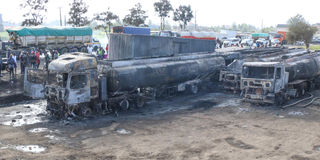Why Nakuru still struggles to curb deadly Petrol tanker accidents

The charred remains of the tankers that exploded in the Pipeline Area on June 14, 2025.
On June 14, two people were hospitalised following an explosion involving a petrol tanker near Pipeline area along the Nakuru–Nairobi highway.
This incident marks yet another worrying development in the county's fuel-related accident trend.
For instance, in April 2025, two workers died in an explosion at Topline Traders Limited's garage in Nakuru. Following this incident, the Energy and Petroleum Regulatory Authority (EPRA) suspended the company's LPG operations.
In 2015, six people were burned to death and several others were seriously injured in Kamara, near Makutano, along the Nakuru–Eldoret highway, when a petrol tanker they were siphoning fuel from caught fire.
In January 2009, tragedy struck Molo when more than 100 people died and hundreds were injured following a petrol tanker explosion. Many of the victims had gathered to scoop and siphon the spilled fuel, unaware of the deadly risk.
Despite repeated warnings, scenes of crowds flocking to the crash sites of petrol tankers to siphon fuel remain common. This behaviour is mostly driven by desperation, curiosity, or a lack of awareness.
Hotspots such as Kikopey in Gilgil, Maai Mahiu in Naivasha and Salgaa in Rongai – areas where petrol tankers would park – remain particularly vulnerable due to their proximity to human settlements and businesses.
Ken Mugo, Nakuru County’s Chief Officer for Disaster Management, says that the pipeline incident involved vehicles parked in an undesignated area.
He announced that the county is seeking to purchase parcels of land along the highway in collaboration with EPRA and the Kenya National Highways Authority (KeNHA) in light of the new Rironi-Mausummit road, which is set to commence in August.
The intention is to establish several designated parking areas for fuel tankers, particularly those transporting LPG or petrol.
'There's an EPRA advert calling for land suitable for designated parking areas. Once established, these zones will be located away from densely populated areas to ensure public safety,” Mugo said in a phone interview.
EPRA had also issued strict specifications for vehicle bodies to manufacturers to help prevent explosions.
To boost emergency preparedness, the county has shortened response times and equipped fire engines with special foam for suppressing petroleum-based fires.
Firefighters also undergo continuous training to handle such high-risk emergencies, and the vehicles are mandated to carry safety equipment including fire extinguishers.
However, Mugo acknowledged the challenge of stopping tankers from parking along the highway, as this boosts the local economy.
"We’re pursuing a multisectoral approach to balance public safety with the economic benefits that these vehicles bring to local communities," he says.
Some areas, such as Salgaa and Maai Mahiu, have already been designated as road reserves for fuel tanker parking, and discussions are ongoing to identify additional safe zones.
Mr Mugo emphasised the need for civic education, noting that bystanders are often the most affected during such incidents.
"We urge the general public to keep a safe distance and allow first responders to manage the situation. If you smell gas or notice a leak, notify the authorities immediately and evacuate the area. Sometimes, even the police are overwhelmed, and controlling crowds becomes difficult. In such moments, people must prioritise their safety," he says.
In the event of a fuel-related emergency, residents are urged to either call the county's toll-free number (0800 724 138) or go directly to the nearest emergency centre: Nakuru (020 2411440), Naivasha (020 2423088) or Molo (020 2400203).


